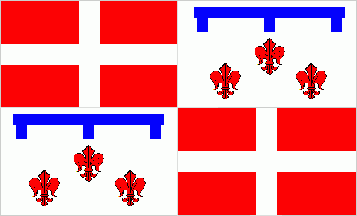
Last modified: 2013-06-25 by rob raeside
Keywords: sovereign and military order of malta | alof de wignacourt | wignacourt | grandmaster |
Links: FOTW homepage |
search |
disclaimer and copyright |
write us |
mirrors
 image
by Klaus-Michael Schneider, 21 October 2008
image
by Klaus-Michael Schneider, 21 October 2008See also:
Flag of Grandmaster Alof de Wignacourt (1601-1622)
It is a quarterly
divided rectangular flag. The 1st and 4th quarter are showing the white Greek
cross in a red field of the Order of St. John. The 2nd and 3rd quarter are
showing the personal arms of the grandmaster. In a silver (= white) field are
three red fleur de lys in a triangular formation one above two. Above the fleur
de lys is a blue label.
Note! This pattern is probably reported erroneously,
for many images of the Wignacourt coat of arms show the fleur de lys in a two
above one formation, for Alof and for Adrienne as well.
Source: I spotted an
image of this flag in Malta National Maritime Museum on 2 October 2008.
Klaus-Michael Schneider, 21 October 2008
The flag of Santa Venera shows three red
fleurs-de-lys on a white central stripe, the same field and the main charges on
the arms of Grand Master Alof de Wignacourt (reigned 1601-1622), "Argent three
fleurs-de-lis Gules a label Azure":
http://www.smom-za.org/smom/grandmasters/54.htm.
According to that
webpage:
"Grand Master de Wignacourt (1601-22) was respected and loved by
the people. He was a man of princely tastes and his suit of armour is one of
the most expensive in existence. During his rule, the Bibliotheca (National
Library) was firmly established, but his name will always be connected with the
aqueduct he built to bring water to Valletta whose population had increased
considerably by this time. He died of apoplexy while he was out shooting."
According to this webpage:
http://www.lapasserelle.com/lm/pagespeciales/anglicistes/malta/charles.fiott/fiottbk3.part1.html
"A more pleasant story [about Santa Venera] is told of the aqueduct that
was constructed between 1610 and 1615, during Grand Master Alof de Wignacourt's
rule (1601-22). The new capital of Valletta was then taking shape, but it was
thirsty. (...) The idea to pipe water from the springs of the northwest, where
it was plentiful, to Valletta, where it was needed, had been proposed many
times. But Santa Venera's elevation had presented a major problem. Based on the
technology available at the time, the only feasible solution was the
construction of a series of arches so that a gradual slope could be maintained.
"As grand master, Wignacourt was expected to pay a "gioja" (gift). Whereas his
predecessors had donated buildings and riches, he paid for the 9-mile aqueduct.
A generous portion of the colonnade still clings to a tower that was
constructed to monitor the flow of the water. (...)"
According to the
Maltese Ministry of Resources and Infrastructure's website:
http://www.mri.gov.mt/works_projects_aqueducts.htm
"The Aqueduct of
Wignacourt is considered to be one of the most important edifices in the
history of engineering. It was way back in 1596 that the first studies were
commissioned so as to find a solution for the acute water shortage in Valletta.
It was consequently decided that the water would be gathered at Rabat and its
surroundings and then taken towards Valletta. The actual works started in 1610
and, after numerous problems regarding both the actual design and finance, was
finished in 1615. The Grand Master at the time was Adolf de Wignacourt, who
paid for the construction out of his own pocket."
A photograph of
Wignacourt's Aqueduct can be seen at that same website:
http://www.mri.gov.mt/downloads/pics/aqueduct_01.jpg
Actually the fleurs-de-lis on the Wignacourt arms are "couped" or "au pied
nourri" i.e., lacking the bottom half, as can be seen in the third and fourth
photographs in this webpage:
http://www.heraldica.org/topics/national/malta2.htm. Apparently the
fleurs-de-lis on the Santa Venera flag (and arms) are
regular ones, at least that is how they look on the official document:
http://groups.yahoo.com/group/flags/files/MT/mt_law)40.jpg. So perhaps the
Wignacourt connection is not true after all.
Santiago
Dotor, 16 March 2006